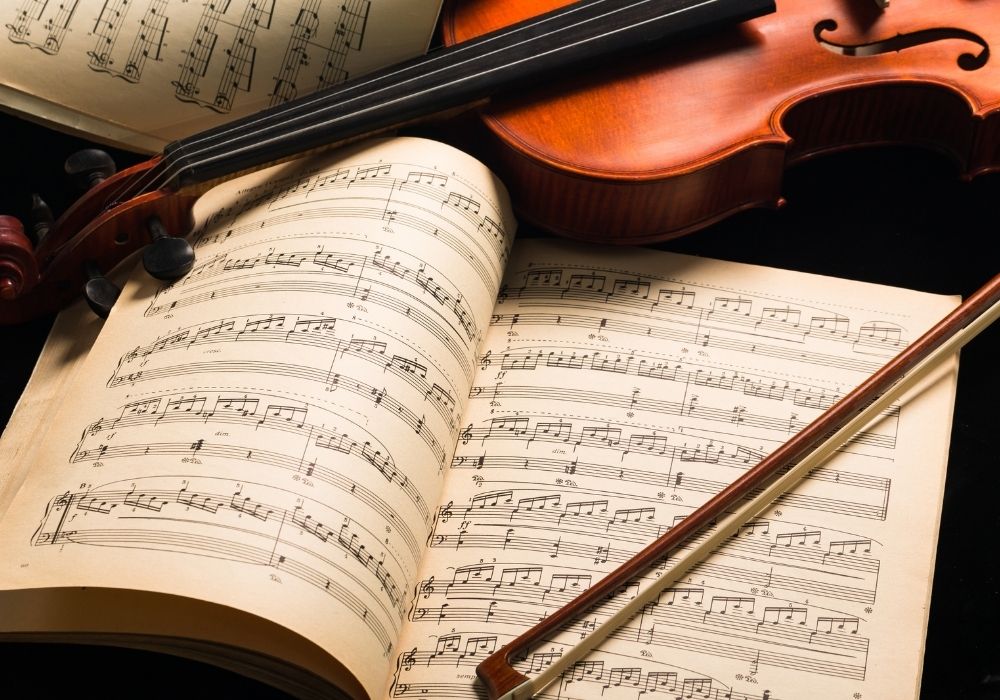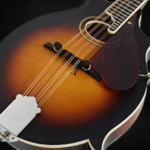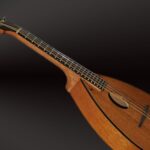There are a ton of options for books to help start your violin journey, and the number of choices can be overwhelming. This guide will help you determine which books are right for you and help you identify the uses of each selection.
I’ll also provide you with ideas for how to practice the skills targeted in each book and give you ideas for integrating them into your daily work.
As a professional violinist and violist, I’ve personally used many of these technique books over and over again, and they’re essential tools for teaching.
Quick Look: Best Beginner Violin Books
★ #1 Best Overall Beginning Violin Technique Book: Art of Violin Playing ★
- Best Beginning Scale Practice for Violin Book: Scale System
- Best Beginner Left-Hand Technique Book for Violin: Sevcik Violin
- Best Beginning Bow Arm Technique Book for Violin: Sevcik Violin
- Best Beginning Rhythm Book for Violin: Rhythmic Training
- Best Advanced Violin Book: Kreutzer – 42 Studies or Caprices
The wonderful thing about the selections listed below is that while they’re intended for beginning players, they can be returned to as students get more advanced, as a way to go back to basics and refine technique.
As such, they’re an investment that can be used over and over again.
What Makes a Great Violin Technique Book?
A great beginning violin technique book should be simple, concise, and easy to use, which will allow you to focus on your setup, tone quality, bow arm, intonation, shifting, scales, and rhythm.

Types of Violin Technique Books
There are hundreds of technique books out there, and they all have specific strengths. Below, you’ll find descriptions of the five main categories and my suggestions for books in each one.
Overall Technique
Violin books that focus on your overall technique will help you with your posture, how you hold your instrument, your bow arm, and the basic techniques that every violinist needs to become proficient at the instrument.
These books have a broad scope and are a wonderful place to start, but it’s important to note that they can’t go in-depth on every topic.
Scales
Scale books are just that. They usually focus on a variety of ways to practice scales and are incredibly important in improving your intonation, familiarity with your instrument, and left-hand/right-hand coordination.
Bow Control
These books focus on your right arm technique and help in improving your bow arm control, tone quality, and flexibility on your instrument.
Intonation and Shifting
While you can get a lot of shifting and intonation practice in your scales, these books focus on specific exercises to improve a variety of shifting skills and are very helpful in improving your intonation and ear training.
Etudes
These books contain a series of exercises to help put individual aspects of your technique into context and practice every aspect of your musicianship, from intonation to bow control, rhythm, and musicality. I love to include these in my daily practice because they allow me to practice the skills I need without the pressure of my official repertoire.
Rhythm
While not specifically a violin technique, good rhythm is essential for every musician. Rhythm technique books help you practice your rhythmic integrity away from your instrument, allowing students to focus solely on the skills at hand.
10 Best Violin Books
Below, you’ll find my 10 favorite beginning violin technique books. These are books I return to daily in my own practice and use over and over again in my teaching.

I’ve made selections in each of the five categories described above and have tried to lay out the strengths of each to help you find the books that are most suited to your violin studies and personal needs.
I hope this guide helps you sort through the choices to find exactly what you need to continue on your violin journey!
 1. Essential Elements for Strings – Book 1
1. Essential Elements for Strings – Book 1
- Author: Michael Allen, Robert Gillespie, Pamela Tellejohn Hayes, and John Higgins
- Length: 48 pages
- Category: Overall technique
- Pros: Comprehensive overall technique book for beginners, and comes with videos to help with instruction.
- Cons: Very broad, and does not go into depth on specific techniques
Essential Elements for Strings – Book 1 is a great book for beginning violin players and is a favorite in many introductory curriculums. It gives students a broad overview of all of the essential techniques of violin playing and provides easy songs to practice while applying these techniques in context.
The book also comes with video supplements, which are incredibly helpful for players who are more visual or auditory learners. They’re also very helpful in figuring out how to practice each exercise.
This is a great book for beginners or those just returning to the instrument, but because it’s so broad, it lacks depth in specific areas of violin technique.
 2. Basics: 300 Exercises and Practice Routines for the Violin
2. Basics: 300 Exercises and Practice Routines for the Violin
- Author: Simon Fischer
- Length: 231 pages
- Category: Overall technique, etudes
- Pros: Incredibly comprehensive and adaptable to each violin student’s needs
- Cons: Because the book is so extensive, it can be overwhelming to sort through all of the information. Go slowly and don’t push yourself to do everything all at once.
Basics: 300 Exercises and Practice Routines for the Violin has it all! Simon Fischer is a well-known violin pedagogue, and this book has everything you need to know about beginning violin technique. It also provides students with an excellent progression in difficulty and skill level, which makes it useful for players of many different skill levels over a long period of time. It’s a great book to return to over and over again.
Because it’s so long and comprehensive, it can be tempting to try to speed through the exercises as quickly as possible. But I strongly suggest that students take their time and master each skill before moving on.
 3. Art of Violin Playing: Book One
3. Art of Violin Playing: Book One
- Author: Carl Flesch
- Length: 192 pages
- Category: Overall technique
- Pros: Comprehensive, covering almost every aspect of basic violin technique. Can be returned to over and over again as your skills improve.
- Cons: Because it’s extremely broad, it lacks specificity for individual aspects of techniques and can be overwhelming at first glance.
Carl Flesch’s Art of Violin Playing is the quintessential text on violin technique and has been referenced by students, teachers, and professional musicians for many years. The book covers topics including Body Posture, The Left Arm, (position and fingerings), Vibrato, Bowing (including all varieties of strokes), Tone Production, Musical Memory, and more, with diagrams and extensive descriptions to provide students with an enormous amount of information and resources.
This book is a great place to start for an overview of violin playing, but it’s important to note that because it’s so broad, it doesn’t go deep in specific topics.
I recommend this book for any student who needs an overview and assistance in starting their work. It’s a good resource to refer back to, but is best used in tandem with other, more targeted texts.
 4. Scale System: Scale Exercises in All Major and Minor Keys for Daily Study
4. Scale System: Scale Exercises in All Major and Minor Keys for Daily Study
- Author: Carl Flesch
- Length: 142 pages
- Category: Scale system
- Pros: Everything you’ll need to master your scale practice, and can be used at any level
- Cons: The level of study goes up quickly, so beginning students will need to move slowly and master the basics before diving into the more advanced techniques covered in this book.
The companion book to Flesch’s Art of Violin Playing, Scale System is the ur-text for violin scale practice. This book goes through every major and minor key, with tons of exercises for scales in every key. My favorite thing about this book is that everything is written out in musical notation, making it far easier to use than other, more condensed scale books.
I love the range of this book and how it can be used by any level of violinist. This is a long-term investment in your daily technique practice and should be in every violinist’s library. If you’re just starting out, go slowly, and be very intentional about your intonation, set up, right-hand/left-hand coordination, and tone quality!
 5. School For Violin Technics: Complete Books 1-3 And Complete Scale Studies
5. School For Violin Technics: Complete Books 1-3 And Complete Scale Studies
- Author: Henry Schradieck
- Length: 128 pages
- Category: Etudes, scales, intonation and shifting
- Pros: Introductory etude studies, excellent for improving finger dexterity and intonation
- Cons: Specifically targets left-hand technique, so if you are looking for a comprehensive overview of technique, this might not be the book for you.
School For Violin Technics is one of my favorite introductory etude books. It’s a great way to warm up on your instrument at the beginning of every practice session and is one of the most effective ways of improving your left-hand dexterity, intonation, and posture.
To practice, start out each exercise at a metronome speed of 40 bpm, and slowly (very slowly!) speed it up as you get more comfortable.
 6. Sevcik Violin Studies – Opus 1, Part 1: School of Violin Technique
6. Sevcik Violin Studies – Opus 1, Part 1: School of Violin Technique
- Author: Otakar Sevcik
- Length: 53 pages
- Category: Intonation and shifting
- Pros: Very detailed and good for all levels
- Cons: Specific to left-hand technique, so if you’re looking for a comprehensive overview technique, this might not be the book for you.
Sevcik’s Op. 1, Part 1 is my other favorite left-hand technique book. The exercises in this book work for any level. They’re a great way for beginning students to focus on their intonation and left-hand technique.
While it’s tempting to rush through these exercises quickly, you’ll lose the benefits of this book if you do that. Go slowly and be a perfectionist about your intonation.
 7. Sevcik Violin Studies – 40 Variations, Opus 3: School of Violin Technique
7. Sevcik Violin Studies – 40 Variations, Opus 3: School of Violin Technique
- Author: Otakar Sevcik
- Length: 30 pages
- Category: Bow control, introductory etudes
- Pros: Wonderful for improving every aspect of your right-hand technique, tone quality, and comfort on the instrument.
- Cons: Specifically targets the right arm
While Sevcik’s Op. 1, Part 1 is excellent for the left hand, his 40 Variations, Opus 3: School of Violin Technique is the best book that I know of for improving right-arm technique. This book goes through every aspect of your bow arm and is the fastest way to improve your bow control and comfort on your instrument.
To practice, don’t worry about getting through the book quickly, but rather move carefully and make sure you’re paying attention to your tone quality.
 8. Preparing for Kreutzer: Volume 1
8. Preparing for Kreutzer: Volume 1
- Author: Harvey S. Whistler
- Length: 56 pages
- Category: Etudes
- Pros: Excellent etude book for beginners
- Cons: Students level out of this book quickly, as it’s for beginning students only.
Preparing for Kreutzer: Volume 1 is an excellent book for students who are starting their etude practice and is a preparation for the next book on my list. These exercises are an opportunity to put every aspect of your technique into context, without the stress of official repertoire.
Once you’ve mastered the exercises in this book, you’ll be ready to move on to book #9!
 9. Kreutzer – 42 Studies or Caprices
9. Kreutzer – 42 Studies or Caprices
- Author: Rodolphe Kreutzer
- Length: 72 pages
- Category: Intermediate etudes
- Pros: Comprehensive intermediate etude book that covers a wide range of skills
- Cons: Wide range of difficulty, not for beginners
Kreutzer’s 42 Studies are a permanent feature of my daily practice. I love the wide range of techniques they cover, with the added bonus of being quite beautiful. This makes the difficulty of practicing etudes far more enjoyable.
I recommend this book to every intermediate and advanced student, and every violinist I know returns to them often, no matter how advanced they are.
 10. Rhythmic Training
10. Rhythmic Training
- Author: Robert Starer
- Length: 86 pages
- Category: Rhythm exercises
- Pros: Can be used by any level of the student, of any instrument
- Cons: Not specific to violin technique
Starer’s Rhythmic Training is the best rhythm exercise book out there. This book is helpful in improving every aspect of your musicianship and specifically your rhythmic integrity.
While it’s not specifically directed towards violin technique, this book has helped me become a better musician in many different ways. I love it because it can be used at any level and returned to again and again.
Review This Post
Table of Contents
In Conclusion
There are many, many violin technique books out there, and every violinist and teacher has opinions on the best ones for their students. This list is subjective and entirely based on my own experience and teaching practice, but I hope that it will help you find a few options to fit your needs.
When you’re looking for a technique book, it’s important to first determine what your individual needs are, and then find the book — or books — that best suit these needs.














